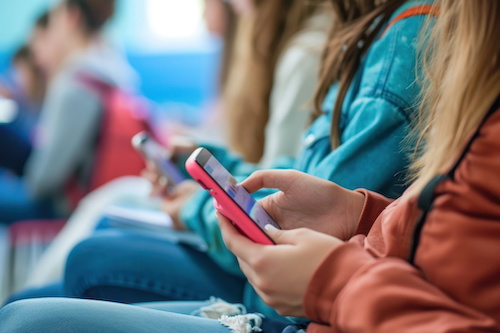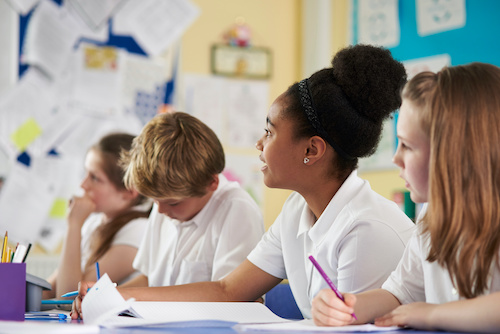This story was originally published by Chalkbeat. Sign up for their newsletters at ckbe.at/newsletters.
Jenn Silverstein’s two children have lived through an active shooter situation at their school. Both attended East High School in Denver last year, when a student shot two administrators at the beginning of the school day.
As the school went on lockdown, her children sat in the auditorium, waiting for guidance and hoping the shooter wouldn’t come in. The only thing they could do was text their mom, looking for comfort and a sense of security.
Having lived through that, Silverstein was profoundly touched when she read the message exchange between sophomore Abby Turner and her mother during the shooting at Apalachee High School in Georgia earlier this month. As she read through the texts, Silverstein immediately thought about the new cell phone bans schools have adopted; at East High, students don’t have to surrender their phones but can’t use them in class.
“It made me realize that the idea of schools going phone-free just doesn’t work for me,” she said.
Silverstein is far from alone. As more states and school districts put cell phone bans in place due to concerns that they distract students from learning and put a strain on children’s mental health, not all parents are on board. Those who are skeptical about the bans express concerns about their ability to communicate about important everyday issues as well as emergencies. Others indicate officials have prohibited cell phones without adequately consulting parents first.
A recent poll of roughly 1,500 parents commissioned by the National Parents Union — or NPU, an advocacy group — found that, among parents whose children take their phones to school, 78% said the reason for doing that is so they can use the device during emergencies.
In addition, 48% cited coordinating transportation, and 45% cited mental health and other needs as reasons they want their children to take their phones to school with them. (The poll did not ask whether parents supported or opposed cell phone bans.)
School cell phone bans take a variety of forms. Some schools require students to put their phones in signal-blocking pouches at the beginning of the day. Some schools require phones to be placed in cases in the front of the classroom. Others just require that students turn them off and keep them inside backpacks. Some schools ban the use of phones just in the classroom. Others ban them during most of the school day.
In fact, 88% of parents in the survey reported that their schools already have policies that limit the use of cell phones, at least partially. Backers of cell phone bans say qualified restrictions can put teachers in a tough spot by making them enforcers and leave significant room for distractions.
These policies have been influenced in part by U.S. Surgeon General Vivek Murthy’s 2023 advisory on the effects of social media on youth mental health. There’s evidence many teachers are concerned about cell phones: 72% claim that the distraction caused by mobile devices is a major problem in the classroom, according to the Pew Research Center. And recent media coverage of cell phones in schools has often been quite critical of their impact on children.
But on the other side are parents with a very fundamental desire: They would like to be able to stay in touch with their kids.
While any one child’s chances of being involved in a mass shooting at school are small, such events have increased in recent decades and can happen anywhere, driving parent fears.
“We have to accept as a fact of life that we have mass murders of children in the nation’s classrooms on a regular basis,” said Keri Rodrigues, president of the National Parents Union.
News stories about mass shootings often feature text messages between parents and children.
Kenneth Trump, the president of National School Safety and Security Services, a consulting firm, said it’s understandable that parents see cell phones as an “emotional security blanket.”
But he said that cell phone use during an emergency can actually increase safety risks. It’s common for parents to drive to schools after receiving a text message from their children. Such an influx of parents during events like school shootings make it harder for authorities to arrive at the site or evacuate students.
“In a critical incident, if you have 20 kids texting, receiving calls, livestreaming, they are not being able to pay attention to the safety guidance fully or to stay alert,” Trump said.
Then there are worries about the public process that’s gone into the bans. According to the NPU survey, 70% of parents say they were not asked for input or feedback on cell phone policies.
But beyond such concerns, communicating with their children plays an important and fundamental emotional role for parents.
“The phone creates a sense of connection. I want them to know that I am there and to be able to say that I love them if God forbid the worst happens,” Silverstein said.
Parents seek compromises about cell phones at school
Despite the safety concerns that divide parents and educators, families do worry about social media’s effects on their children’s academic performance and mental health.
Among the parents surveyed by the NPU, 76% said schools’ current cell phone policies successfully prevent the devices “from distracting students during instruction time.”
There are approaches that might address both parents’ and educators’ concerns. One way is for parents to work around the policies established by schools by using other types of devices.
When Issac Soto, a father of two in Victorville, Calif., learned that cell phones weren’t allowed during school hours, he invested in smartwatches so that his children could communicate directly with the family in an emergency.
“We also don’t want them to text their friends or watch videos in class,” said Soto.
Rodrigues of the National Parents Union said she uses an app called Aura that lets her manage things like what apps and websites her kids can go to on their phones.
Schools’ policies about phones are still evolving. Different schools and districts are still discussing bans, and some parents have said they will simply defy the policies if they don’t consider families’ needs.
But more than focusing on bans, it’s important to think broadly about cell phones’ role in children’s lives, said Michelle Ciulla Lipkin, executive director of the National Association for Media Literacy Education.
“They must build skills to make a healthy use of their phones, even when they are out of school or when they graduate,” she said. “We must create interventions that allow for an open debate about when and how they use their phones and access social media.”
Soto’s children, who are 8 and 5 years old, are just starting to develop these skills. Still, he hopes that by the time they reach high school, they will have developed skills to use their devices more responsibly and render a cell phone ban unnecessary, but also experience less violence at school.
“This world is a lot different than what we grew up in, and we need their help to help them be better than us, and not to go through the problems that we do,” Soto said.
Chalkbeat is a nonprofit news organization covering public education.
Related:
School safety impacts achievement, instructional time, educator retention
Lax NYC school cell phone policies put burden on teachers, leave students confused
For more on education policy, visit eSN’s Educational Leadership hub
Jenn Silverstein’s two children have lived through an active shooter situation at their school. Both attended East High School in Denver last year, when a student shot two administrators at the beginning of the school day. District Management, Educational Leadership, Featured on eSchool News, children, day, high school, kids, parents, SAT, school, security, story, student eSchool News








